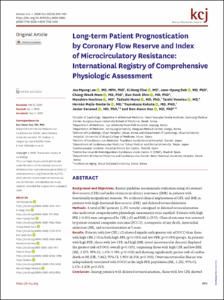KUMEL Repository
1. Journal Papers (연구논문)
1. School of Medicine (의과대학)
Dept. of Internal Medicine (내과학)
Long-term Patient Prognostication by Coronary Flow Reserve and Index of Microcirculatory Resistance: International Registry of Comprehensive Physiologic Assessment
- Affiliated Author(s)
- 남창욱
- Alternative Author(s)
- Nam, Chang Wook
- Journal Title
- Korean Circulation Journal
- ISSN
- 1738-5555
- Issued Date
- 2020
- Keyword
- Myocardial ischemia; Coronary artery disease; Fractional flow reserve; Coronary flow reserve; Index of microcirculatory resistance; Percutaneous coronary intervention
- Abstract
- Background and Objectives:
Recent guideline recommends evaluation using of coronary flow reserve (CFR) and index of microcirculatory resistance (IMR) in patients with functionally insignificant stenosis. We evaluated clinical implications of CFR and IMR in patients with high fractional flow reserve (FFR) and deferred revascularization.
Methods:
A total of 867 patients (1,152 vessels) consigned to deferred revascularization who underwent comprehensive physiologic assessments were enrolled. Patients with high FFR (>0.80) were categorized by CFR (≤2) and IMR (≥23 U). Clinical outcome was assessed by patient-oriented composite outcome (POCO), a composite of any death, myocardial infarction (MI), and revascularization at 5 years.
Results:
Patients with low CFR (≤2) showed significantly greater risk of POCO than those with high CFR (>2) in both high-FFR (p=0.024) and low-FFR (p=0.034) groups. In patients with high FFR, those with low CFR and high IMR (overt microvascular disease) displayed the greatest risk of POCO overall (p=0.015), surpassing those with high CFR and low IMR (HR, 2.873; 95% CI, 1.476–5.594; p=0.002) and showing significantly greater risk of cardiac death or MI (HR, 5.662; 95% CI, 1.984–16.154; p=0.001). Overt microvascular disease was independently associated with POCO in the high-FFR population (HR, 2.282; 95% CI, 1.176–4.429; p=0.015).
Conclusion:
Among patients with deferred revascularization, those with low CFR showed significantly greater risk of POCO than those with high CFR, regardless of FFR. In patients with high FFR, those with overt microvascular disease showed significantly greater risk of POCO and cardiac death or MI at 5-year, compared with the others.
- Department
- Dept. of Internal Medicine (내과학)
- Publisher
- School of Medicine (의과대학)
- Citation
- Joo Myung Lee et al. (2020). Long-term Patient Prognostication by Coronary Flow Reserve and Index of Microcirculatory Resistance: International Registry of Comprehensive Physiologic Assessment. Korean Circulation Journal, 50(10), 890–903. doi: 10.4070/kcj.2020.0083
- Type
- Article
- ISSN
- 1738-5555
- Appears in Collections:
- 1. School of Medicine (의과대학) > Dept. of Internal Medicine (내과학)
- 파일 목록
-
-
Download
 oak-2020-0658.pdf
기타 데이터 / 1.75 MB / Adobe PDF
oak-2020-0658.pdf
기타 데이터 / 1.75 MB / Adobe PDF
-
Items in Repository are protected by copyright, with all rights reserved, unless otherwise indicated.